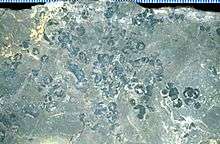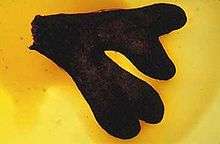Protosalvinia
Protosalvinia is a prehistoric plant found commonly in shale from shoreline habitats of the Upper Devonian period. The name Protosalvinia is a misnomer. The name literally means early Salvinia, and was given in the erroneous belief that the fossils were an earlier form of the living aquatic fern Salvinia. It is no longer believed that the fossils come from a fern, but deciding exactly what the fossils represent is still a matter of debate. This is surprising when one considers how much is known about the fossils.
| Protosalvinia Temporal range: Late Devonian | |
|---|---|
 | |
| Fossil of P. furcata from Devonian shale of Kentucky, USA. | |
| Scientific classification | |
| Kingdom: | Plantae |
| Division: | incertae sedis |
| Order: | †Protosalviniales |
| Family: | †Protosalviniaceae |
| Genus: | †Protosalvinia Dawson (1886) |
| Type species | |
| †Protosalvinia punctata (Newton) Dawson (1886)[1] | |
| Species | |
| |
| Synonyms[2][3] | |
| |
The most likely interpretation of Protosalvinia is that it represents either a fossil liverwort or brown alga, although no definitive brown algae have been identified from before the Tertiary period,[4] and examination of the spore structure shows no features in common with living groups of brown algae.[5] The living plant was a thallus with short dichotomous branching. The branches in the largest species were as much as one centimeter across. In some fossils, the branching lobes lie flat, but in others the tips of the branches are curled up over the fossil, giving it a round outline. Embedded in the tissues of the thallus are chambers in which spores (200 micrometre diameter) were produced by meiosis.[6]

Because Protosalvinia is usually preserved as a compression fossil, it can be difficult to determine whether its anatomy is more like a plant or an alga. Some biochemical evidence favors interpretation as an alga.[7] Lignin and cutin have been found in the thalli, and sporopollenin in the spore walls.[8]:64 The grouping of the spores found in the thallus favors interpretation as a plant. The absence of any stomata on the surface is inconclusive, as all bryophytes lack stomata on the main body of the plant.
However, the tips of Protosalvinia branches show evidence of conceptacle-like dips.[8]:64
Protosalvinia is found in association with conodont elements.[9]
For the present, the relationships of Protosalvinia remain uncertain.
References
- "Protosalvinia". IFPNI. Retrieved 2020-05-05.
- Lang, W. H. (1945). "Pachytheca and some anomalous early plants (Prototaxites, Nematothallus, Parka, Foerstia, Orvillea n.g.)". Botanical Journal of the Linnean Society. 52: 535–552. doi:10.1111/j.1095-8339.1945.tb01351.x.
- Schopf, J. M. (1978). "Foerstia and recent interpretations of early, vascular land plants". Lethaia. 11 (2): 139–143. doi:10.1111/j.1502-3931.1978.tb01298.x.
- Speer, B. R.; Waggoner, B. M. (2000). "Phaeophyta: Fossil Record".
- Taylor, W. A.; Taylor, T. N. (1987). "Spore wall ultrastructure of Protosalvinia". American Journal of Botany. 74 (3): 437–443. doi:10.2307/2443819. JSTOR 2443819.
- Niklas, K. J.; Phillips, T. L. (1976). "Morphology of Protosalvinia from the Upper Devonian of Ohio and Kentucky". American Journal of Botany. 63 (1): 9–29. doi:10.2307/2441665. JSTOR 2441665.
- Niklas, Karl J. (1976). "Organic chemistry of Protosalvinia (=Foerstia) from the Chattanooga and New Albany Shales". Review of Palaeobotany and Palynology. 22 (4): 265–279. doi:10.1016/0034-6667(76)90026-9.
- Wilson N. Stewart; Gar W. Rothwell. (1992). Paleobotany and the evolution of plants. New York: Cambridge University Press. ISBN 978-0-521-38294-6.
- D. JEFFREY OVER1; REMUS LAZAR,2; GORDON C. BAIRD,3 ;JUERGEN SCHIEBER4; AND FRANK R. ETTENSOHN5 (2009). "PROTOSALVINIA DAWSON AND ASSOCIATED CONODONTS OF THE UPPER TRACHYTERA ZONE, FAMENNIAN, UPPER DEVONIAN, IN THE EASTERN UNITED STATES". Journal of Paleontology. 83 (1).CS1 maint: multiple names: authors list (link)
Further reading
- Kenrick, Paul & Crane, Peter R. (1997). The Origin and Early Diversification of Land Plants: A Cladistic Study. Washington, D. C.: Smithsonian Institution Press. ISBN 1-56098-730-8.
- Stewart, Wilson N. & Rothwell, Gar W. (1993). Paleobotany and the Evolution of Plants (2nd ed.). Cambridge: Cambridge University Press. ISBN 0-521-38294-7.
- Taylor, Thomas N. & Taylor, Edith L. (1993). The Biology and Evolution of Fossil Plants. Englewood Cliffs, NJ: Prentice Hall. ISBN 0-13-651589-4.